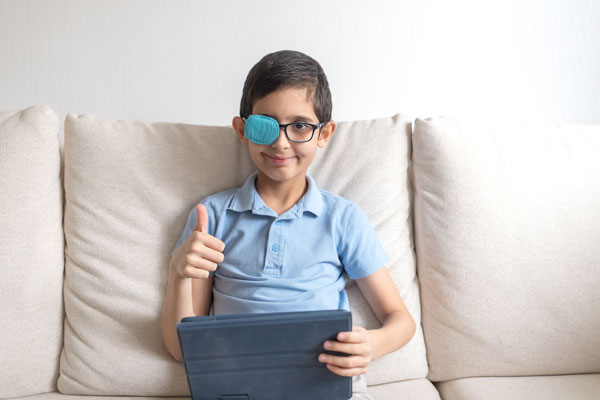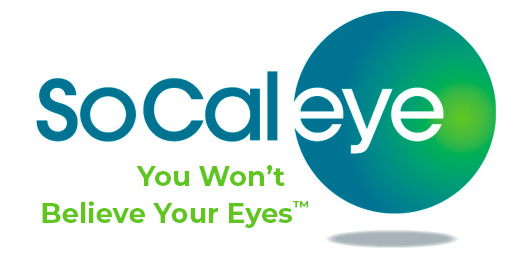
Lazy Eye or Amblyopia is one of the most common pediatric eye conditions. It generally occurs in children under 7 years old and is the leading cause of vision impairment in children. With early detection and treatment Lazy Eye can be fully cured with no residual effects.
What is Lazy Eye / Amlyopia?
Lazy eye (amblyopia) is reduced vision in one eye caused by abnormal visual development early in life. The weaker — or lazy — eye often wanders inward or outward. In rare cases lazy eye affects both eyes. The eye with poorer vision can usually be corrected with glasses or contact lenses, or patching therapy. Early diagnosis and treatment can help prevent long-term problems and untreated, lazy eye can cause permanent vision loss.
Amblyopia Causes and Risk Factors
Causes:
Lazy eye occurs in young, developing eyes when the nerve pathways between a thin layer of tissue (retina) at the back of the eye and the brain fail to develop properly. When a weaker eye receives fewer visual signals, the ability for eyes to work together decreases and the brain suppresses input from the weaker eye.
Anything that blurs a child’s vision or causes the eyes to cross or turn out can result in lazy eye. Common causes of the condition include:
- Muscle Imbalance (strabismus amblyopia). The most common cause of lazy eye is an imbalance in the muscles that position the eyes. This imbalance can cause the eyes to cross in or turn out, and prevents them from working together.
- Difference in Refraction (refractive amblyopia). A significant difference between the prescriptions in each eye — often due to farsightedness but sometimes to nearsightedness or an uneven surface curve of the eye (astigmatism) — can result in lazy eye.
- Combination. In some children lazy eye is caused by a combination of strabismus and refractive problems.
- Deprivation (Deprivation amblyopia) This is the most severe type of amblyopia and is a problem with one eye — such as droopy eye lids or a cloudy area in the lens (cataract) — can cause vision loss. This requires urgent treatment to prevent permanent vision loss.
Risk Factors:
Factors associated with an increased risk of lazy eye include:
- Premature birth
- Small size at birth
- Family history of lazy eye
- Developmental disabilities
Lazy Eye Symptoms and Detection:
Symptoms:
Signs and symptoms of lazy eye include:
- An eye that wanders inward or outward
- Eyes that appear to not work together
- Poor depth perception
- Squinting or shutting an eye
- Head tilting
- Abnormal results of vision screening tests
Sometimes lazy eye in a child is not evident without an eye exam, but if you notice his or her eye wandering after the first few weeks of life it is advisable to schedule an appointment with an eye doctor. A complete eye exam is recommended between ages 3 and 5 but given that Amblyopia is often hereditary, parents with a family history of crossed eyes should arrange for an eye exam earlier.
Detection:
Amblyopia is usually detected and diagnosed during an infant’s first eye exam. See American Optometric recommendations for exams for children.
Treatment:
Once diagnosed it is important to start treatment for lazy eye without delay in childhood while the interaction between the eye and the brain are still forming. Treatment is most effective before age 7 but children can respond to treatment up until 17.
Treatment options depend on the cause of lazy eye and on how much the condition is affecting your child’s vision. The following treatment options exist::
- Corrective eyewear. Glasses or contact lenses can correct problems such as nearsightedness, farsightedness or astigmatism that result in lazy eye.
- Eye patches. A patch is placed over the stronger eye for 2-6 hours per day to stimulate the weaker eye.
- Bangerter filter. Works in the same way as patching therapy, A special filter is placed on the eyeglass that blurs the stronger eye.
- Eyedrops. A medication that blurs vision in the stronger eye in order to strengthen the weaker eye. The medication is called atropine (Isopto Atropine).
- Surgery. In the case of Deprivation Amblyopia, surgery may be necessary to correct droopy eyelids or cataracts.
For most children with lazy eye, proper treatment improves vision within weeks to months. Treatment might last from six months to two years.
Lazy Eye/Amblyopia Summary
Lazy Eye occurs in 2-4% of children and is usually detected in younger children at their first eye exam. Treatment is effective and can restore vision correctly in a relatively short period of time. Early Diagnosis is critical for treatment and cure. SoCal Eye Doctors are experienced in the detection and treatment of Lazy Eye.



